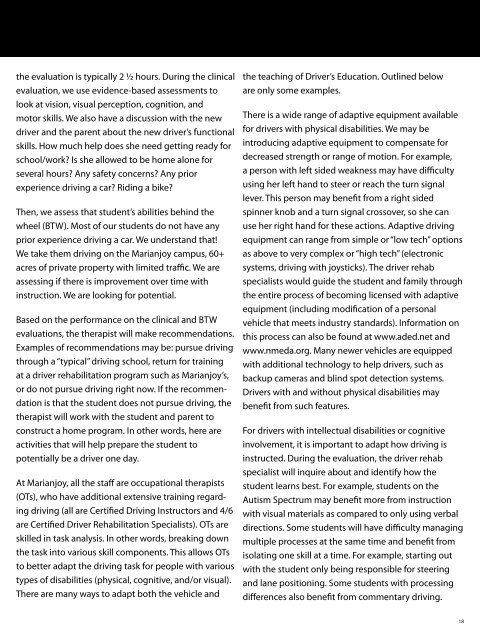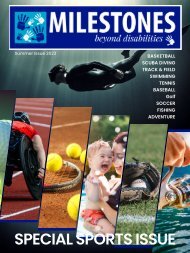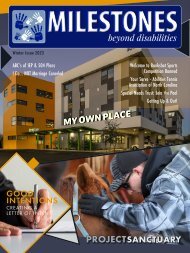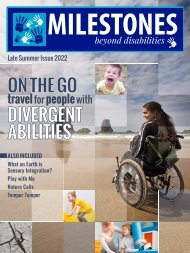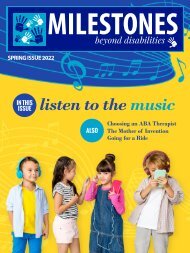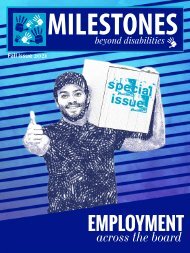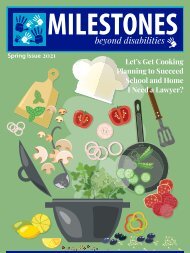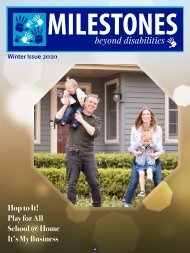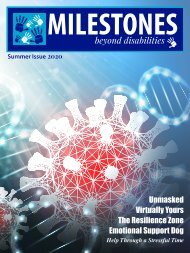Milestones Magazine - Summer 2019
Helping individuals with disabilities and their families achieve and celebrate events and milestones in their lives.
Helping individuals with disabilities and their families achieve and celebrate events and milestones in their lives.
Create successful ePaper yourself
Turn your PDF publications into a flip-book with our unique Google optimized e-Paper software.
the evaluation is typically 2 ½ hours. During the clinical<br />
evaluation, we use evidence-based assessments to<br />
the teaching of Driver’s Education. Outlined below<br />
are only some examples.<br />
look at vision, visual perception, cognition, and<br />
motor skills. We also have a discussion with the new<br />
driver and the parent about the new driver’s functional<br />
skills. How much help does she need getting ready for<br />
school/work? Is she allowed to be home alone for<br />
several hours? Any safety concerns? Any prior<br />
experience driving a car? Riding a bike?<br />
There is a wide range of adaptive equipment available<br />
for drivers with physical disabilities. We may be<br />
introducing adaptive equipment to compensate for<br />
decreased strength or range of motion. For example,<br />
a person with left sided weakness may have difficulty<br />
using her left hand to steer or reach the turn signal<br />
lever. This person may benefit from a right sided<br />
Then, we assess that student’s abilities behind the<br />
wheel (BTW). Most of our students do not have any<br />
prior experience driving a car. We understand that!<br />
We take them driving on the Marianjoy campus, 60+<br />
acres of private property with limited traffic. We are<br />
assessing if there is improvement over time with<br />
instruction. We are looking for potential.<br />
spinner knob and a turn signal crossover, so she can<br />
use her right hand for these actions. Adaptive driving<br />
equipment can range from simple or “low tech” options<br />
as above to very complex or “high tech” (electronic<br />
systems, driving with joysticks). The driver rehab<br />
specialists would guide the student and family through<br />
the entire process of becoming licensed with adaptive<br />
equipment (including modification of a personal<br />
Based on the performance on the clinical and BTW<br />
evaluations, the therapist will make recommendations.<br />
Examples of recommendations may be: pursue driving<br />
through a “typical” driving school, return for training<br />
at a driver rehabilitation program such as Marianjoy’s,<br />
or do not pursue driving right now. If the recommendation<br />
is that the student does not pursue driving, the<br />
vehicle that meets industry standards). Information on<br />
this process can also be found at www.aded.net and<br />
www.nmeda.org. Many newer vehicles are equipped<br />
with additional technology to help drivers, such as<br />
backup cameras and blind spot detection systems.<br />
Drivers with and without physical disabilities may<br />
benefit from such features.<br />
therapist will work with the student and parent to<br />
construct a home program. In other words, here are<br />
activities that will help prepare the student to<br />
potentially be a driver one day.<br />
For drivers with intellectual disabilities or cognitive<br />
involvement, it is important to adapt how driving is<br />
instructed. During the evaluation, the driver rehab<br />
specialist will inquire about and identify how the<br />
At Marianjoy, all the staff are occupational therapists<br />
(OTs), who have additional extensive training regarding<br />
driving (all are Certified Driving Instructors and 4/6<br />
are Certified Driver Rehabilitation Specialists). OTs are<br />
skilled in task analysis. In other words, breaking down<br />
the task into various skill components. This allows OTs<br />
to better adapt the driving task for people with various<br />
types of disabilities (physical, cognitive, and/or visual).<br />
There are many ways to adapt both the vehicle and<br />
student learns best. For example, students on the<br />
Autism Spectrum may benefit more from instruction<br />
with visual materials as compared to only using verbal<br />
directions. Some students will have difficulty managing<br />
multiple processes at the same time and benefit from<br />
isolating one skill at a time. For example, starting out<br />
with the student only being responsible for steering<br />
and lane positioning. Some students with processing<br />
differences also benefit from commentary driving.<br />
18


